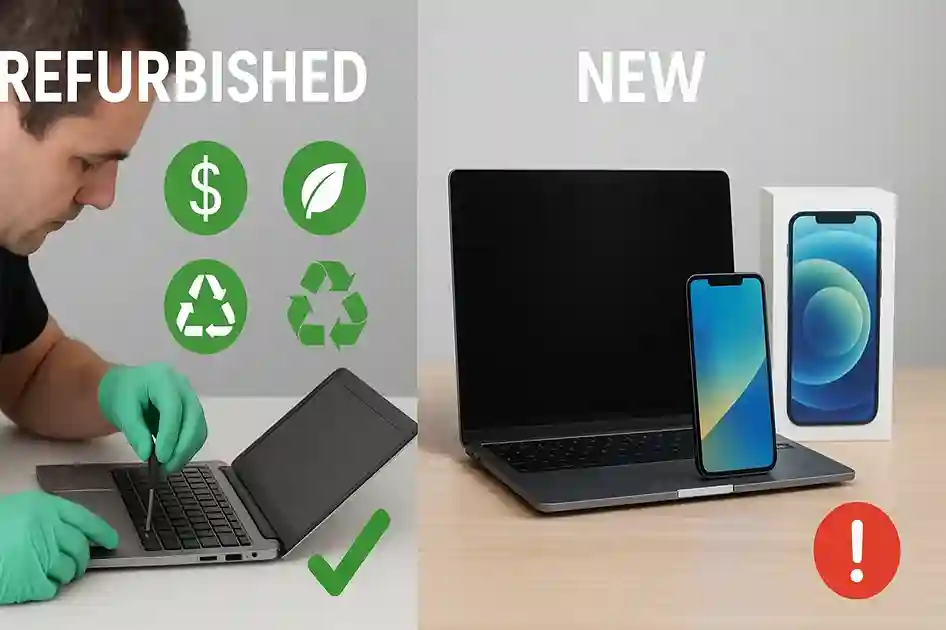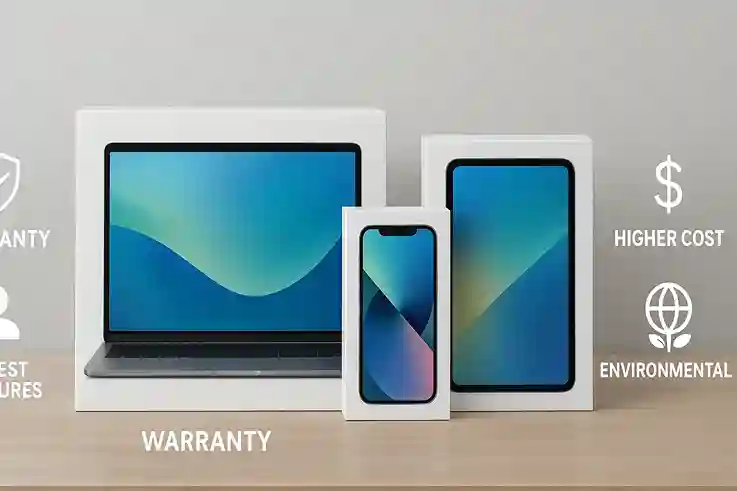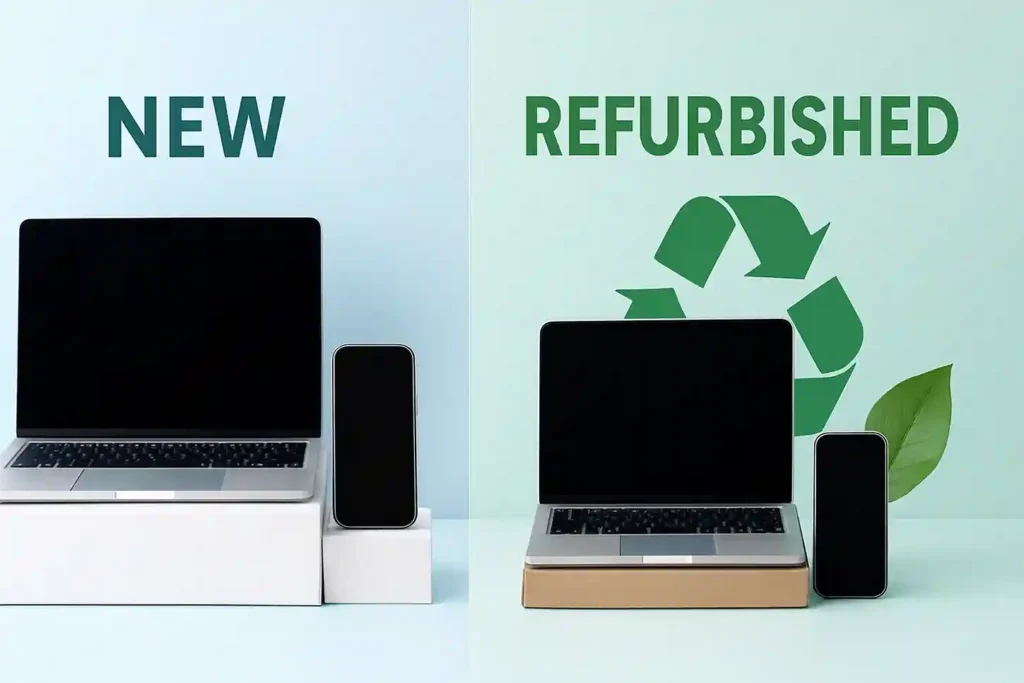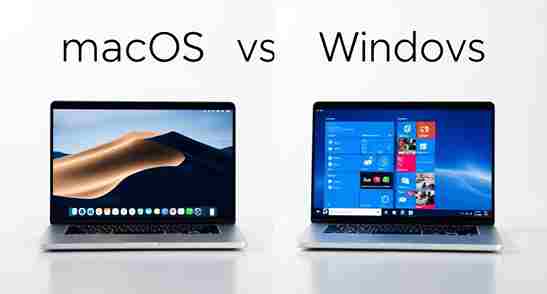The debate of Refurbished vs New products grows stronger each year. Shoppers face tough choices with rising costs and changing priorities. Many now look at refurbished items for big savings. Others value them for sustainability and reduced waste.
New products bring the comfort of untouched quality and manufacturer warranties. Yet refurbished items provide real value without heavy spending. Both options have strengths. Both also carry risks. This guide explains Refurbished vs New in clear terms. It helps you weigh cost, quality, and long-term use. By the end, you’ll know which choice matches your needs and budget.
What Does “Refurbished” Mean?

A refurbished product is not brand new. It was returned, repaired, and tested before resale. The goal is to restore function and quality. Refurbished vs New differs from other terms. A used item is sold as-is with no repairs. An open-box item was returned but shows little to no use. Refurbished products sit in the middle. They are checked, fixed if needed, and often cleaned.
Refurbishment can be done by manufacturers or trusted third-party sellers. Manufacturer refurbishing usually includes stricter testing and official warranties. Third-party sellers may offer lower prices but sometimes with shorter guarantees.
What Does “New” Really Mean?
A brand-new product has never been owned or used. It comes directly from the manufacturer or authorized retailer. Packaging is sealed, and every part is untouched. Refurbished vs New makes sense here. New items bring peace of mind. They include full warranties, the latest features, and zero wear. Buyers still prefer new because of trust. There are no hidden issues, no past repairs, and no uncertainty. For many, that security outweighs higher prices.
Refurbished vs New: Key Differences
When comparing Refurbished vs New, the differences often come down to budget, warranty, and long-term value. Refurbished products can save you a significant amount of money and support eco-friendly shopping, but they may come with a shorter lifespan or limited warranty. New products, on the other hand, offer peace of mind with full warranty coverage, flawless quality, and higher resale value—but at a higher cost. Ultimately, the smarter choice depends on whether you value savings and sustainability or long-term reliability and brand-new condition.
| Factor | Refurbished Products | New Products |
|---|---|---|
| Price | 20–50% cheaper than new; great for budget-conscious buyers. | Full retail price; often more expensive, especially for the latest models. |
| Warranty | May come with limited or shorter warranty (30 days–1 year, depending on seller). | Standard full warranty (1–2 years or more, depending on brand). |
| Quality | Inspected, repaired, and tested, but may show slight cosmetic signs of use. | Brand-new condition, flawless appearance, and guaranteed performance. |
| Lifespan | Usually shorter than new, depending on previous usage and refurbishment quality. | Longest possible lifespan since the product hasn’t been used before. |
| Resale Value | Lower resale value; often harder to resell at a good price. | Higher resale value, especially for popular brands/models. |
| Environmental Impact | Eco-friendly option—extends product lifecycle, reduces e-waste. | Less eco-friendly, contributes to manufacturing demand and higher e-waste. |
Pros and Cons of Buying Refurbished

Cost Savings
In the Refurbished vs New debate, the biggest advantage of going refurbished is without a doubt price. Refurbished items typically cost 20% to 50% less than new ones, making them especially appealing to budget-conscious buyers. This price gap allows shoppers to own premium brands, higher-end models, or upgraded features at a fraction of the original cost.
For students, small businesses, or anyone trying to save money, refurbished products offer access to reliable technology and appliances without overspending. While refurbished items may come with shorter warranties or minor cosmetic flaws, the significant upfront savings often outweigh these drawbacks.
Eco-Friendly Choice
Another major advantage in the Refurbished vs New comparison is the positive effect refurbished products have on the environment. Instead of being discarded, items are repaired, tested, and reused, which helps reduce e-waste and the demand for new manufacturing. Every refurbished purchase extends the life of a product and keeps it out of landfills.
For eco-conscious buyers, choosing refurbished means supporting sustainability and a circular economy. It lowers carbon emissions, conserves resources, and reduces the overall environmental footprint. While new products often come with the latest technology, their production requires new raw materials, packaging, and energy—factors that increase their impact on the planet.
By opting for refurbished, buyers save money and actively contribute to a greener, more sustainable future.
Access to Older Models
One often-overlooked benefit in the Refurbished vs New debate is availability. When new versions of a device are launched, older models are usually discontinued and disappear from retail stores. However, refurbished markets often keep these models in circulation, giving buyers access to products that are no longer officially sold as new.
This can be especially helpful for people who prefer familiar designs, specific features, or reliable models that newer versions may have replaced. For example, some users favor the size, headphone jack, or keyboard layout of older devices that are no longer included in updated versions. Refurbished products make it possible to keep using what works best for you, without being forced into the latest upgrade.
In short, refurbished shopping isn’t just about saving money—it’s also about choice and flexibility.
Shorter Warranty
One of the biggest downsides in the Refurbished vs New debate is warranty length. While brand-new products usually come with a full manufacturer’s warranty—often 1 to 2 years—refurbished items may only include limited coverage ranging from 30 days to 12 months, depending on the seller.
This shorter protection period adds a level of risk if repairs or replacements are needed. Buyers have less time to discover hidden issues, and coverage may not be as comprehensive as with new products. That said, purchasing from reputable retailers or certified refurbishers can reduce the risk, as they often provide extended warranties or return policies to build buyer confidence.
For shoppers weighing Refurbished vs New, warranty coverage is a critical factor: while refurbished saves money upfront, new products provide more peace of mind in the long run.
Possible Hidden Issues
Quality is another important consideration in the Refurbished vs New discussion. Refurbished products go through testing, repairs, and inspections to ensure they work properly, which reduces the chances of major defects. However, no system is perfect—some items may still show minor cosmetic wear, reduced battery life, or shorter overall lifespan compared to a brand-new product.
With new products, buyers get the advantage of flawless condition and maximum durability, since the item has never been used. Refurbished items, on the other hand, require buyers to accept a small degree of uncertainty. The risk can be minimized by purchasing from certified refurbishers or trusted brands, which usually guarantee a higher level of quality control.
Ultimately, refurbished products can deliver excellent value, but when comparing Refurbished vs New, new products still provide the greatest reliability and longevity.
Limited Stock
Another factor to consider in the Refurbished vs New debate is availability. Refurbished products depend on returns, trade-ins, and repairs, which means stock levels can change quickly. Popular models often sell out fast, and finding the exact color, storage size, or configuration you want may take more time compared to buying new.
Resale value is usually lower with refurbished or recertified items. Because they’ve had a previous owner, these products often depreciate faster and are harder to resell at a strong price. In contrast, new items tend to hold value longer, especially when they’re current-generation models from trusted brands.
For buyers who prioritize specific models or strong resale potential, new products usually win. But for those who value upfront savings and flexibility, refurbished items can still be a smart choice.
Pros and Cons of Buying New

Full Warranty
In the Refurbished vs New comparison, one of the strongest advantages of new products is their warranty coverage. Most brand-new items come with a full manufacturer warranty, often lasting one to two years or longer depending on the product. This gives buyers confidence that if something goes wrong, repairs or replacements will be handled at little to no cost.
This level of protection is especially important for high-value purchases like smartphones, laptops, or appliances, where repair costs can be expensive. With refurbished items, warranties are often shorter or limited, which adds some risk. New products remove much of that uncertainty, making them the safer choice for buyers who prioritize peace of mind and long-term reliability.
Latest Features
A clear advantage of new products in the Refurbished vs New debate is access to the newest technology, designs, and upgrades. When you buy new, you’re guaranteed the latest features—whether that means faster processors, better battery performance, improved cameras, or modern design updates.
For buyers who want the cutting edge without compromise, new products deliver the full experience. This is especially important in fast-moving industries like smartphones, laptops, and home electronics, where even a year can mean major performance differences. Refurbished products, while cost-effective, typically belong to older generations, meaning some advanced features may be missing.
In short, new products ensure you’re always at the front of innovation, while refurbished items focus more on value and affordability.
Peace of Mind
Another major advantage of buying new in the Refurbished vs New debate is the confidence factor. A brand-new product has no past owners, meaning there are no hidden repairs, no signs of wear, and no uncertainty about how it was used before. Buyers know exactly what they’re getting: a product in perfect condition, straight from the manufacturer or retailer.
This peace of mind is one of the main reasons many people are willing to pay more for new items. The higher cost isn’t just about having the latest model—it’s about eliminating risk. With refurbished products, even when certified, there’s always a small possibility of reduced lifespan or unnoticed issues. New products, by contrast, guarantee reliability and trust, which is invaluable to many buyers.
Higher Cost
The biggest drawback in the Refurbished vs New debate is the price of new products. Brand-new items almost always come with a premium cost, and in many cases, they are significantly more expensive than refurbished alternatives. For some buyers, this extra expense may not feel justified—especially when refurbished products can offer comparable performance at a much lower price.
This cost gap is most noticeable in electronics, appliances, and high-end devices, where the newest models command top dollar at launch. While some shoppers are willing to pay for peace of mind, warranty coverage, and the latest features, others see more value in stretching their budget with refurbished options.
In short, new products guarantee reliability but at a higher financial trade-off, which may not make sense for every buyer.
Rapid Depreciation
Another important point in the Refurbished vs New debate is depreciation. Electronics and gadgets lose value quickly—sometimes within just a few months of purchase. A brand-new phone or laptop, for example, may drop in price shortly after launch when newer models or seasonal sales appear.
This means that buyers who purchase new often face the steepest initial depreciation, while refurbished buyers skip that early drop in value by purchasing after the product has already been discounted. Refurbished items usually start at a lower price, so their resale value doesn’t fall as sharply.
For buyers who like to upgrade frequently or resell their devices later, depreciation is an important factor to consider. New products deliver the latest features, but refurbished items often provide better overall value retention.
Environmental Impact
One drawback of choosing new in the Refurbished vs New debate is the environmental cost. Every new product manufactured requires raw materials, energy, and packaging, which increases demand on natural resources and contributes to waste. Electronics, in particular, involve mining, plastics, and shipping—each adding to carbon emissions and long-term environmental impact.
For eco-minded shoppers, this is a serious concern. Buying refurbished helps extend the life of existing devices and reduces e-waste, while choosing new can accelerate consumption cycles and landfill growth. While many brands are improving their sustainability practices, new products still carry a heavier ecological footprint compared to refurbished alternatives.
In short, if environmental impact is a deciding factor, refurbished often wins in the Refurbished vs New comparison.
Refurbished vs New: Pros and Cons at a Glance
| Aspect | Refurbished | New |
|---|---|---|
| Price | Lower cost, big savings | Higher cost, premium pricing |
| Warranty | Often shorter, sometimes limited | Full manufacturer warranty |
| Features | May lack the newest features | Latest technology and designs |
| Condition | Repaired, tested, cleaned — but previously owned | Completely unused and untouched |
| Availability | Limited stock, depends on returns | Always available when released |
| Environmental Impact | Eco-friendly, reduces waste | More resource use, higher environmental cost |
| Depreciation | Already depreciated, holds value better | Rapid depreciation after purchase |
| Model Options | Older or discontinued models available | Only current or latest models |
| Peace of Mind | Some risk of hidden issues | No hidden history, full buyer confidence |
When to Choose Refurbished vs New
When Refurbished Makes Sense
A refurbished product fits well if you need savings. It works for students, families, or anyone on a tight budget.
It’s also ideal when you want older models no longer sold as new. Many people choose refurbished for secondary devices like backup laptops or spare phones.
For eco-conscious buyers, refurbished also supports sustainability goals.
When Buying New Is Better
New products are the right choice for cutting-edge technology. They provide the latest features and top performance without compromise.
They also suit buyers who want long-term reliability and full warranty coverage.
For high-value purchases like flagship smartphones, premium appliances, or work laptops, new often makes more sense. The peace of mind outweighs the higher price.
Quick Checklist: Refurbished vs New
Ask yourself these questions before deciding:
- Is my budget tight right now? → Go refurbished.
- Do I need the newest features? → Go new.
- Am I buying a backup or secondary device? → Go refurbished.
- Do I want a full warranty and maximum reliability? → Go new.
- Is sustainability a top priority for me? → Go refurbished.
- Am I making a long-term, high-value purchase? → Go new.
Tips for Buying Refurbished Safely
When weighing Refurbished vs New, one concern buyers often have is trust. While refurbished products can save you money, it’s important to shop smart to avoid risks. Here are a few key tips:
- Buy from trusted sellers or manufacturers – Stick to reputable retailers, brand outlets, or certified refurbishers. This ensures proper testing and repairs.
- Check warranty and return policies – Even refurbished items should come with some form of coverage. Look for at least a short warranty and a clear return policy.
- Look for certified refurbished labels – Certified products meet higher standards, having been tested, repaired, and approved by the original manufacturer or authorized partners.
Following these steps can greatly reduce the uncertainty of buying refurbished and give you more confidence in your purchase. With the right precautions, refurbished items can deliver excellent value while minimizing risk.
FAQs: Refurbished vs New
Conclusion: Which Is Worth Your Money?
When comparing Refurbished vs New, there is no one-size-fits-all answer. Refurbished products offer significant cost savings, environmental benefits, and continued availability of older models, making them a smart choice for budget-conscious and eco-minded buyers. They provide great value, though with slightly shorter warranties, minor cosmetic wear, and potential uncertainty in lifespan.
New products, on the other hand, provide full warranties, the latest technology, and complete peace of mind. Buyers pay more upfront, but they gain reliability, long-term usability, and the confidence that comes with owning a brand-new device.
Ultimately, the right choice depends on your priorities. If you value savings and sustainability, refurbished is worth considering. If you prioritize cutting-edge features, warranty coverage, and long-term reliability, new products may be the better investment. By weighing these factors carefully, you can make a well-informed decision and get the best value for your money.
💬 What about you? Have you bought refurbished before, or do you always go new?
Share your experience in the comments — your story might help another reader decide.

Amina Pierce is a tech-savvy blogger with a specialty in electronics, where she shares practical insights on gadgets, innovations, and the latest trends shaping our digital world. With a strong interest in how technology impacts everyday life, she breaks down complex topics into clear, easy-to-understand articles for readers of all backgrounds. While electronics is her main focus, Amina also enjoys writing on a variety of other subjects, including lifestyle, travel, and personal growth, making her content both diverse and engaging.
Outside of blogging, Amina loves tinkering with new devices, exploring smart home solutions, and capturing her experiences through travel photography. Her blend of technical knowledge and approachable style makes her a trusted source of information and inspiration.


